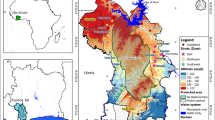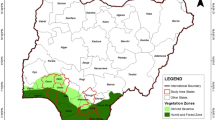Abstract
Cocoa yields in Côte d’Ivoire are low and falling each year, partly as a result of full-sun cropping systems. Thus, interest is now high in establishing sustainable cocoa agroforestry systems through the re-introduction of shade trees. This article uses data collected from a sample of 400 cocoa farmers in the Soubré region of Côte d’Ivoire to analyze farmers’ current and intention to plant trees in their cocoa farms in the future and the motivation for their decision. Logit regressions are used to assess the various determinants of current tree planting behaviour and future adoption intention. Results show that both current and likelihood of deliberately planting trees with cocoa in the future is significantly affected by extension and certification programs, severity of diseases affecting cocoa, and geographic zone. Future intentions to associate trees with cocoa are further influenced by the age of the farmers, household size and the average age of the cocoa farm. To increase the adoption of tree planting in cocoa fields there is the need to intensify extension messages on the benefit of shade trees in cocoa farms especially in areas where adoption intention is still low. Where awareness is high, adoption can be increased through the supply of seedlings and provision of specific trainings on planting density and management techniques to ensure that agroforestry has the maximum positive effect.


Similar content being viewed by others
References
Adesina AA, Baidu-Forson J (1995) Farmers’ perceptions and adoption of new agricultural technology: evidence from analysis in Burkina Faso and Guinea, West Africa. Agric Econ 13(1):1–9
Adesina AA, Mbila D, Nkamleu GB, Endamana D (2000) Econometric analysis of the determinants of adoption of alley farming by farmers in the forest zone of southwest Cameroon. Agric Ecosyst Environ 80(3):255–265
Adrian Anne, Norwood Shannon, Mask Paul (2005) Producers’ perceptions and attitudes toward precision agriculture technologies. Comput Electron Agric 48:256–271
Asare R (2005) Cocoa agroforests in West Africa: a look at activities on preferred trees in the farming systems. Forest and Landscape Working Papers No. 6-2005, Copenhagen. http://curis.ku.dk. Accessed 15 July 2013
Assiri AA, Kacou EA, Assi FA, Ekra KS, Dji KF, Couloud JY, Yapo AR (2012) Rentabilité économique des techniques de réhabilitation et de replantation des vieux vergers de cacaoyers (Theobroma cacao L.) en Côte d’Ivoire. J Anim Plant Sci 14(2):1939–1951
Casey JF, Caviglia JL (2000) Deforestation and agroforestry adoption in tropical forests: can we generalize? Some results from Campeche, Mexico and Rondônia, Brazil. Paper presented at the western agricultural economics association annual meetings, Vancouver, British Columbia, 29 June–1 July
Cloug Y, Faust H, Tscharntk T (2009) Cacao boom and bust: sustainability of agroforests and opportunities for biodiversity conservation. Conserv Lett 2:197–205
Current D, Lutz E, Scherr SJ (1995) The costs and benefits of agroforestry to farmers. World Bank Res Obs 10(2):151–180
D’Souza G, Cyphers D, Phipps T (1993) Factors affecting the adoption of sustainable agricultural practices. Agric Resour Econ Rev 22(2):159–165
Degrande A, Schreckenberg K, Mbosso C, Anegbeh P, Okafor V, Kanmegne J (2006) Farmers’ fruit tree-growing strategies in the humid forest zone of Cameroon and Nigeria. Agrofor Syst 67(2):159–175
Franzel S (1999) Socioeconomic factors affecting the adoption potential of improved tree fallows in Africa. Agrofor Syst 47(1–3):305–321
Garforth C, McKemey K, Rehman T, Tranter R, Cooke R, Park J, Dorward P, Yates C (2006) Farmers’ attitudes towards techniques for improving oestrus detection in dairy herds in South West England. Livest Sci 103:158–168
Gibson J (2007) Consistently inconsistent: addressing income volatility among cocoa producers in Ghana and Côte d’Ivoire. International Institute for Sustainable Development, Winnipeg, pp 1–48
Gyau A, Chiatoh M, Franzel S, Asaah E, Donovan J (2012) Determinants of farmers’ tree planting behaviour in the North West region of Cameroon: the case of Prunus africana. Int For Rev 14(3):265–274
Jagoret P, Michel-Dounias I, Malézieux E (2011) Long-term dynamics of cocoa agroforests: a case study in central Cameroon. Agrofor Syst 81:267–278
Kouadjo J, Kého Y, Mosso RA, Toutou KG, Nkamleu GB, Gockowski J (2002) Production et offre du cacao et du café en Côte d’Ivoire. Survey Report, ENSEA-Sustainable Tree Crops Program, International Institute of Tropical Agriculture, Abidjan, Cote d’Ivoire
Matata PZ, Ajayil OC, Oduol PA, Agumya A (2008) Socio-economic factors influencing adoption of improved fallow practices among smallholder farmers in Western Tanzania. Int NGO J 3(4):68–73
Mercer DE (2004) Adoption of agroforestry innovations in the tropics: a review. New vistas in agroforestry. Springer, Netherlands, pp 311–328
Neupane RP, Sharma KR, Thapa GB (2002) Adoption of agroforestry in the hills of Nepal: a logistic regression analysis. Agric Syst 72(3):177–196
Ofori-Frimpong K, Asase A, Mason J, Danku L (2007) Shaded versus unshaded cocoa: implications on litter fall, decomposition, soil fertility and cocoa pod development. Presented at the symposium on multistrata agroforestry systems with perennial crops, CATIE Turrialba, Costa Rica, 17–21 Sept 2007
Pattanayak SK, Mercer DE, Sills E, Yang JC (2003) Taking stock of agroforestry adoption studies. Agrofor Syst 57(3):173–186
Pawarda C, Gadzirayi CT, Muriritirwa WT, Mwenye D (2010) Adoption of agroforestry technologies among smallholder farmers: a case of Zimbabwe. J Dev Agric Econ 2(10):351–358
Peterson JS, Tembo L, Kawimbe C, Mwangamba E (1999) The Zambia Integrated Agroforestry Project baseline survey: lessons learned in Chadiza, Chipata, Katete and Mambwe districts, Eastern Province, Zambia. World Vision, University of Florida and Ministry of Agriculture, Chipata
Prokopy LS, Floress K, Klotthor-Weinkauf D, Baumgart-Getz A (2008) Determinants of agricultural best management practice adoption: evidence from the literature. J Soil Water Conserv 63(5):300–311
Rezaei-Moghaddam K, Salehi S (2010) Agricultural specialists’ intention toward precision agriculture technologies: integrating innovation characteristics to technology acceptance model. Afr J Agric Res 5(11):1191–1199
Ruf F (2001) Tree crops as deforestation and reforestation agents: the case of cocoa in Côte d’Ivoire and Sulawesi. In: Anglesen A, Kaimowitz D (eds) Agricultural technologies and tropical deforestation. CABI Publishing, Oxon, pp 291–315
Smoot K, Gyau A, Kouame C, Diby L (2013) Understanding the drivers of tree presence and densities in cocoa agroforestry systems in the Republic of Côte d’Ivoire. Agrofor Syst (in review)
Sood KK, Mitchell CP (2006) Importance of human psychological variables in designing socially acceptable agroforestry systems. For Trees Livelihoods 16(2):127–137
Verhees F, Meulenberg M, Pennings J (2005) The influence of market factors on intention to adopt a ‘Radical’ product innovation by farmers. Paper prepared for presentation at the American Agricultural Economics Association Annual Meeting, Providence, Rhode Island, 24–27 June 2005
World Agroforestry Center (ICRAF) (2011) Cocoa sustainability in Cote d’ivoire. World Agroforestry Center Vision for Change Project, Soubre, Cote d’Ivoire, pp 1–23
Zubair M, Garforth C (2006) Farm level tree planting in Pakistan: the role of farmers’ perceptions and attitudes. Agrofor Syst 66(3):217–229
Acknowledgments
The field research conducted for this article would not have been possible without a tremendous amount of support and assistance by the staff of ICRAF Côte d’Ivoire’s Vision for Change (V4C) project. The authors are particularly grateful to all the village-based technicians who assisted to organize surveys and focus group meetings. Financial support for this work was provided by the US Borlaug fellowship and ICRAF under the Vision for Change project.
Author information
Authors and Affiliations
Corresponding author
Rights and permissions
About this article
Cite this article
Gyau, A., Smoot, K., Kouame, C. et al. Farmer attitudes and intentions towards trees in cocoa (Theobroma cacao L.) farms in Côte d’Ivoire. Agroforest Syst 88, 1035–1045 (2014). https://doi.org/10.1007/s10457-014-9677-6
Received:
Accepted:
Published:
Issue Date:
DOI: https://doi.org/10.1007/s10457-014-9677-6




